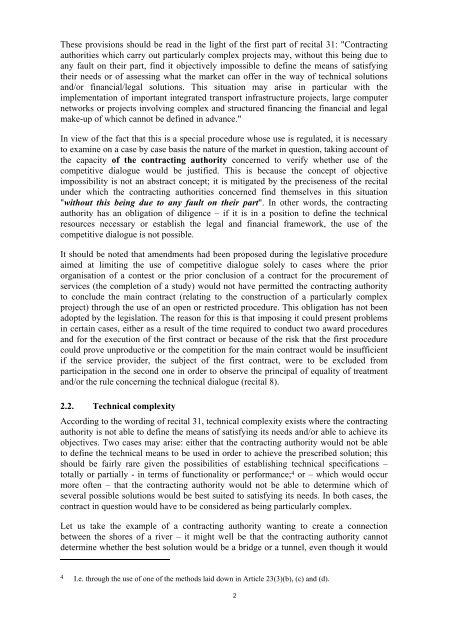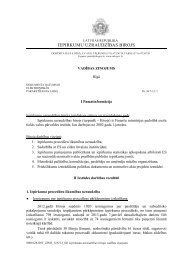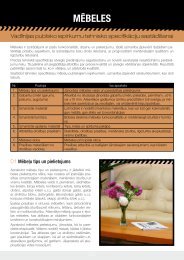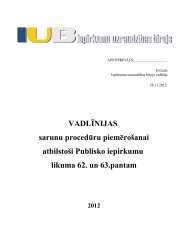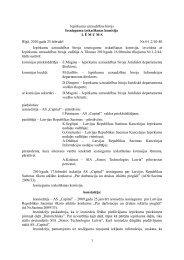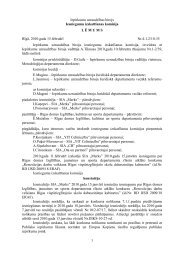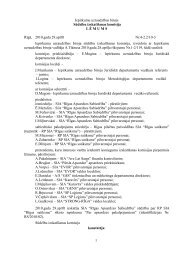Explanatory Note - Competitive Dialogue - European Commission
Explanatory Note - Competitive Dialogue - European Commission
Explanatory Note - Competitive Dialogue - European Commission
You also want an ePaper? Increase the reach of your titles
YUMPU automatically turns print PDFs into web optimized ePapers that Google loves.
These provisions should be read in the light of the first part of recital 31: "Contracting<br />
authorities which carry out particularly complex projects may, without this being due to<br />
any fault on their part, find it objectively impossible to define the means of satisfying<br />
their needs or of assessing what the market can offer in the way of technical solutions<br />
and/or financial/legal solutions. This situation may arise in particular with the<br />
implementation of important integrated transport infrastructure projects, large computer<br />
networks or projects involving complex and structured financing the financial and legal<br />
make-up of which cannot be defined in advance."<br />
In view of the fact that this is a special procedure whose use is regulated, it is necessary<br />
to examine on a case by case basis the nature of the market in question, taking account of<br />
the capacity of the contracting authority concerned to verify whether use of the<br />
competitive dialogue would be justified. This is because the concept of objective<br />
impossibility is not an abstract concept; it is mitigated by the preciseness of the recital<br />
under which the contracting authorities concerned find themselves in this situation<br />
"without this being due to any fault on their part". In other words, the contracting<br />
authority has an obligation of diligence – if it is in a position to define the technical<br />
resources necessary or establish the legal and financial framework, the use of the<br />
competitive dialogue is not possible.<br />
It should be noted that amendments had been proposed during the legislative procedure<br />
aimed at limiting the use of competitive dialogue solely to cases where the prior<br />
organisation of a contest or the prior conclusion of a contract for the procurement of<br />
services (the completion of a study) would not have permitted the contracting authority<br />
to conclude the main contract (relating to the construction of a particularly complex<br />
project) through the use of an open or restricted procedure. This obligation has not been<br />
adopted by the legislation. The reason for this is that imposing it could present problems<br />
in certain cases, either as a result of the time required to conduct two award procedures<br />
and for the execution of the first contract or because of the risk that the first procedure<br />
could prove unproductive or the competition for the main contract would be insufficient<br />
if the service provider, the subject of the first contract, were to be excluded from<br />
participation in the second one in order to observe the principal of equality of treatment<br />
and/or the rule concerning the technical dialogue (recital 8).<br />
2.2. Technical complexity<br />
According to the wording of recital 31, technical complexity exists where the contracting<br />
authority is not able to define the means of satisfying its needs and/or able to achieve its<br />
objectives. Two cases may arise: either that the contracting authority would not be able<br />
to define the technical means to be used in order to achieve the prescribed solution; this<br />
should be fairly rare given the possibilities of establishing technical specifications –<br />
totally or partially - in terms of functionality or performance; 4 or – which would occur<br />
more often – that the contracting authority would not be able to determine which of<br />
several possible solutions would be best suited to satisfying its needs. In both cases, the<br />
contract in question would have to be considered as being particularly complex.<br />
Let us take the example of a contracting authority wanting to create a connection<br />
between the shores of a river – it might well be that the contracting authority cannot<br />
determine whether the best solution would be a bridge or a tunnel, even though it would<br />
4 I.e. through the use of one of the methods laid down in Article 23(3)(b), (c) and (d).<br />
2


